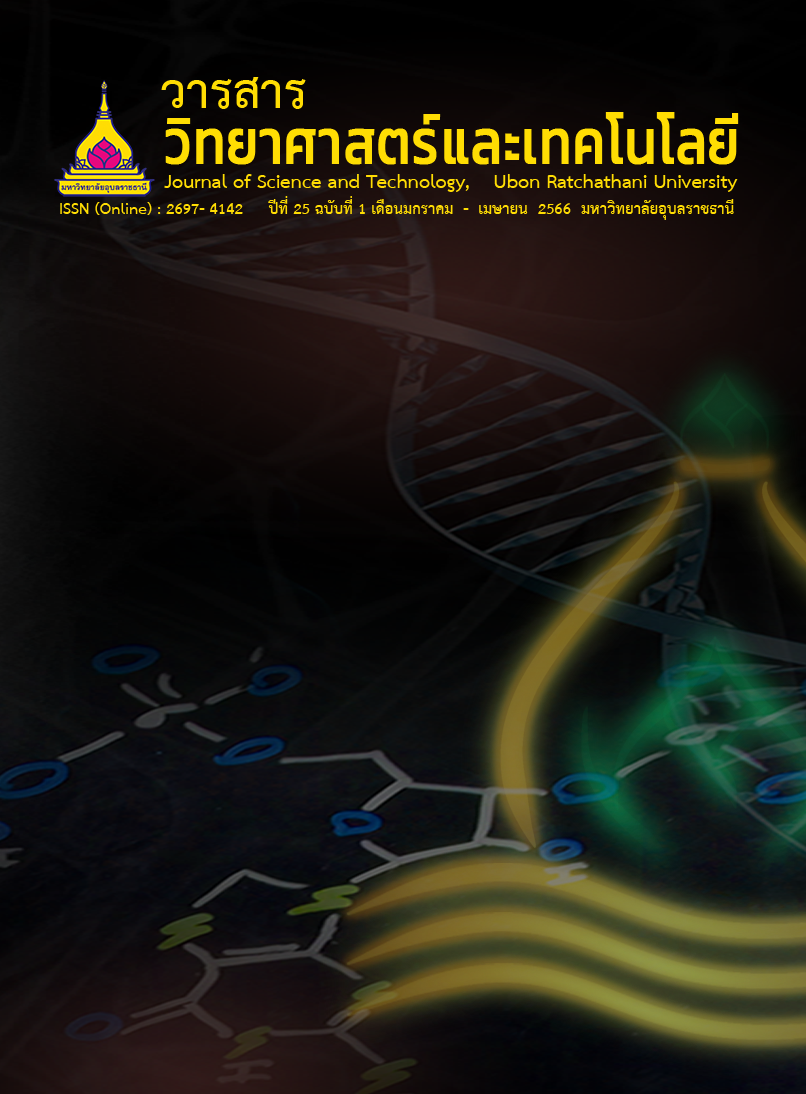ผลของอุณหภูมิการเผาต่อคุณสมบัติทางเคมีกายภาพและความสามารถในการยับยั้งเชื้อรา ของนาโนซิงค์ออกไซด์ที่เตรียมโดยวิธีโซลเจล
Main Article Content
บทคัดย่อ
ซิงค์ออกไซด์เป็นวัสดุที่เป็นมิตรต่อสิ่งแวดล้อม และมีความสามารถในการยับยั้งจุลินทรีย์ได้หลายชนิด การสังเคราะห์ซิงค์ออกไซด์ให้มีโครงสร้างในระดับนาโนสามารถช่วยเพิ่มศักยภาพในการใช้ประโยชน์ ในการศึกษานี้ได้สังเคราะห์นาโนซิงค์ออกไซด์ด้วยวิธีโซลเจล โดยใช้อุณหภูมิการเผาที่ 300, 500 และ 700 องศาเซลเซียส งานวิจัยนี้มีวัตถุประสงค์เพื่อศึกษาผลของอุณหภูมิการเผาต่อคุณสมบัติทางเคมีกายภาพของนาโนซิงค์ออกไซด์ และความสามารถของสารดังกล่าวในการยับยั้งเชื้อรา Aecidium mori (Barclay) Barclay ซึ่งเป็นสาเหตุของโรคราสนิมในหม่อน การศึกษาและวิเคราะห์คุณสมบัติของนาโนซิงค์ออกไซด์ใช้เทคนิคการเลี้ยวเบนรังสีเอกซ์ (XRD) การวิเคราะห์ธาตุเชิงพลังงานของรังสีเอกซ์ (EDS) กล้องจุลทรรศน์อิเล็กตรอนแบบส่องกราดชนิดฟิลด์อีมิสชัน (FESEM) เทคนิคฟูเรียร์ทรานฟอร์มอินฟราเรดสเปกโทรสโกปี (FTIR) และการวิเคราะห์พื้นที่ผิวจำเพาะตามวิธีการของ Brunauer-Emmett-Teller (BET) ส่วนการศึกษาความสามารถในการยับยั้งเชื้อราใช้วิธี poisoned food technique จากการทดลองพบว่าอนุภาคซิงค์ออกไซด์ที่สังเคราะห์ขึ้นมีโครงสร้างผลึกแบบเฮกซะโกนอลเวิร์ทไซท์ ขนาดอนุภาคอยู่ในระดับนาโน มีพื้นที่ผิวจำเพาะ 6.381-16.487 ตารางเมตรต่อกรัม และมีความสามารถในการยับยั้งเชื้อรา โดยนาโนซิงค์ออกไซด์ที่สังเคราะห์ที่อุณหภูมิการเผา 300 องศาเซลเซียส ที่มีความเข้มข้น 3,000 ไมโครกรัมต่อมิลลิลิตรในอาหารเลี้ยงเชื้อ potato dextrose agar มีความสามารถในการยับยั้งเชื้อราสูงที่สุด นอกจากนี้ยังพบว่า นาโนซิงค์ออกไซด์ที่สังเคราะห์ที่อุณหภูมิการเผาที่ต่างกันมีขนาดอนุภาค พื้นที่ผิวจำเพาะ และความสามารถในการยับยั้งเชื้อราที่แตกต่างกัน
Article Details

อนุญาตภายใต้เงื่อนไข Creative Commons Attribution-NonCommercial-NoDerivatives 4.0 International License.
บทความที่ได้รับการตีพิมพ์เป็นลิขสิทธิ์ของ วารสารวิทยาศาสตร์และเทคโนโลยี มหาวิทยาลัยอุบลราชธานี
ข้อความที่ปรากฏในบทความแต่ละเรื่องในวารสารวิชาการเล่มนี้เป็นความคิดเห็นส่วนตัวของผู้เขียนแต่ละท่านไม่เกี่ยวข้องกับมหาวิทยาลัยอุบลราชธานี และคณาจารย์ท่านอื่นๆในมหาวิทยาลัยฯ แต่อย่างใด ความรับผิดชอบองค์ประกอบทั้งหมดของบทความแต่ละเรื่องเป็นของผู้เขียนแต่ละท่าน หากมีความผิดพลาดใดๆ ผู้เขียนแต่ละท่านจะรับผิดชอบบทความของตนเองแต่ผู้เดียว
เอกสารอ้างอิง
Manjunatha, S.E. and et al. 2020. Assortment for host resistance and eco-friendly management of mulberry powdery mildew caused by Phyllactinia corylea (Pers.) Karst. Journal of Pharmacognosy and Phytochemistry. 9(3): 2159-2162.
Adhikari, M.K. 2019. Aecidium mori (Barclay) Barclay (rust fungus) parasitic on Morus alba L.: A new record for Nepal. Journal of Plant Resources. 17(1): 3-5.
Aime, M.C. and McTaggart, A.R. 2021. A higher-rank classification for rust fungi, with notes on genera. Fungal Systematics and Evolution. 7: 21-47.
Helfer, S. 2014. Rust fungi and global change. New Phytologist. 201:770-780.
Vijayakumar, S. and et al. 2021. Potential eco-friendly Zinc Oxide nanomaterials through Phyco-nanotechnology - A review. Biocatalysis and Agricultural Biotechnology. 35: 102050.
Jabar, A. and et al. 2017. Synthesis nano zinc oxide materials and their activity on fungus growth. Engineering and Technology Journal. 35(1): 76-84.
Thakur, S., Neogi, S. and Ray, A.K. 2021. Morphology controlled synthesis of ZnO nanostructures for caffeine degradation and Escherichia coli inactivation in water. Catalysts. 11(1): 1-18.
Sakaroj, S. and et al. 2020. A potential of thai fruit peel extracts for green synthesis of ZnO nanoparticles. In: Proceedings of the 58th Kasetsart University Annual Conference, 5-7 February 2020. Bangkok, Thailand. (in Thai)
Kalasung, S. and Horprathum, M. 2018. Effects of precursor concentration on morphology and photocatalytic property of ZnO nanorod prepared by hydrothermal method. Thai Science and Technology Journal. 28(2): 230-240. (in Thai)
Pitsamai, S. 2015. Effect of ZnO nanoparticles on the antifungal of mango cv. Nam dok mai. In: Proceedings of the 2nd National Research Conference of Nakhonratchasima College, 18-19 June 2015. Nakhonratchasima, Thailand. (in Thai)
Tedsree, N. and Tedsree, K. 2016. Anti-phytopathogenic fungal activity of nano zinc oxide. Songklanakarin Journal of Plant Science. 3(Suppl.): 7-14. (in Thai)
Pholnak, C. 2017. Zinc oxide nanoparticles and antimicrobial resistance. Thai Journal of Physics. 34(3-4): 37-47. (in Thai)
Arciniegas-Grijalba, P.A. and et al. 2017. ZnO nanoparticles (ZnO-NPs) and their antifungal activity against coffee fungus Erythricium salmonicolor. Applied Nanoscience. 7: 225-241.
Sangchay, W. and Ubolchollakhat, K. 2016. Photocatalytic and antibacterial activities of ZnO powders prepared via a sol-gel method. KKU Engineering Journal. 43(1): 21-25. (in Thai)
Sudheer Kumar, K.H., Dhananjaya, N. and Yadav, L.S.R. 2018. E. tirucalli plant latex mediated green combustion synthesis of ZnO nanoparticles: Structure, photoluminescence and photo-catalytic activities. Journal of Science: Advanced Materials and Devices. 3(3): 303-309.
Khamklieng, U. and et al. 2018. Biofilm coating from garlic extracts plus biosurfactant against fungal pathogens on mangoes (Nam Dok Mai). Huachiew Chalermprakiet Science and Technology Journal. 4(1): 113-123. (in Thai)
Kenyotha, N. and Laokul, P. 2019. Preparation of zinc oxide hollow spheres and their application as photoanode in dye sensitized solar cell. Burapha Science Journal. 24(3): 913-928. (in Thai)
Chabattula, S.C. and et al. 2021. Anticancer therapeutic efficacy of biogenic Am-ZnO nanoparticles on 2D and 3D tumor models. Materials Today Chemistry. 22: 100618.
Sabeeh, S.H. and Jassam, R.H. 2018. The effect of annealing temperature and Al dopant on characterization of ZnO thin films prepared by sol-gel method. Results in Physics. 10(2018): 212-216.
Qi, S., Jianmei, L. and Tao, L. 2018. Zinc oxide nanoparticle as a novel class of antifungal agents: Current advances and future perspectives. Journal of Agricultural and Food Chemistry. 66: 11209-11220.


